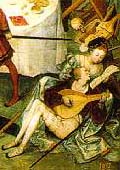Drawn by overhanging branches and deep shade, I sidestepped down a pebbly incline to the dirty little inlet of the river that lies behind the old railroad trestle. An overturned shopping cart, there for as long as I can recall, rusted quietly in muck at the shoreline. Fresh, low greenery was quickly overtaking the upslope to the path, and wild iris and arrowheads were rising from the mudflats.
It was quiet, and beautiful. Even the half buried and half submerged trash seemed mythic artifacts, variations of Eliot's "garlic and sapphires in the mud/clot the bedded axle tree."



White petals were drifting downward through the air, and lay scattered underfoot, and when I looked back toward the path, I saw this:

The hundreds of blossoms floating in the dark water toward the black mouth of the culvert seemed like souls heading into the underworld. I suppose, it strikes me now, that I could have as easily been reminded of a tunnel of love. These were blossoms, after all, and it's springtime, the season when Persephone ascends from the underworld into the light.
But it doesn't feel like a moral springtime. All day yesterday the image of George Bush standing beside Pope John Paul made me physically ill. As much I despair at the Pope's historically unprogressive teachings on gender, I admire his promotion of peace and social justice. The images of George and Laura smarmily condescending to a religious thinker of John Paul's stature were truly nauseating. Bush's transparent attempt to appropriate the Pope's moral authority and attach it to his own grimy little elective war was as embarrassing as it was offensive.
Gazing at the blossons drifting into the culvert, I thought of Breughel's "Triumph of Death." In the painting, an army of the dead, ghoulishly rioting, is driving a crowd of the living into a tunnel

as, in the lower right corner, a prince and a courtesan make music and love.

The painting presents a grisly panorama ofdeath and mayhem. I wrote an ekphrastic poem about it in 1989.
II.
In the corner of Brueghel's Triumph of Death
a lutanist sings between the silk-draped knees
of a singing courtesan. Together they could represent
the triumph of Art and Love in the time of plague.
But the triumph is clearly Death's:
the landscape seethes in a thick impasto
of gore and smoke, fire and rot,
under the biliary yellow of a fin-du-temps sky.
Death has spilled the backgammon,
the ice bucket, the blackjack game:
the courtesan alone ignores the ghastly scene
that forms the backdrop of this spoiled feast --
the Totentanz of the armies of the Dead.
They drive the living into a wooden tunnel like a coffin,
and on each side of it there are more of them, a countless
mass of the Dead, gathered behind their coffin-lid shields.
From foreground to horizon they riot and scourge,
mock and burn , showing mercy to no one
between the bloody sand and the tilting Catherine wheels --
not to king, priest, mother, peasant, babe or fool.
Within the green rampart of her skirt he sings;
his gaze pleads, hers falls , coy, onto the cool page;
she is shy of both her suitors: of him,
and of the grinning one behind her,
who saws away at his viole da braccio
as she sings her division upon two grounds:
love's and death's.
Each August 6th, in Hiroshima, thousands of paper lanterns are launched on the Motoyasu River to commemorate the A-bomb dead -- paper, flame and water, in beautiful, elemental equilibrium. The antithesis of the terrible, smelting conflagrations of the bombs.
Blossoms drifting toward a culvert's mouth.
No comments:
Post a Comment